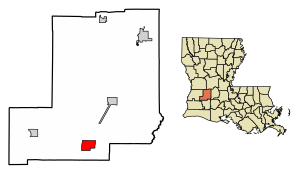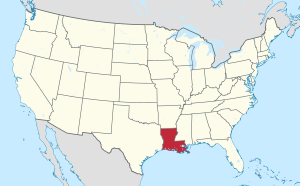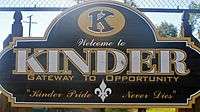Kinder, Louisiana facts for kids
Quick facts for kids
Kinder, Louisiana
|
|
|---|---|
|
Town
|
|

Ashy Municipal Building is named for former Kinder Mayor Fred A. Ashy
|
|

Location of Kinder in Allen Parish, Louisiana.
|
|

Location of Louisiana in the United States
|
|
| Country | United States |
| State | Louisiana |
| Parish | Allen |
| Town | 1911 |
| Government | |
| • Type | Mayor and Town Council |
| Area | |
| • Total | 5.53 sq mi (14.31 km2) |
| • Land | 5.53 sq mi (14.31 km2) |
| • Water | 0.00 sq mi (0.00 km2) |
| Elevation | 46 ft (14 m) |
| Population
(2020)
|
|
| • Total | 2,170 |
| • Density | 392.76/sq mi (151.64/km2) |
| Time zone | UTC-6 (CST) |
| • Summer (DST) | UTC-5 (CDT) |
| Area code(s) | 337 |
| FIPS code | 22-39755 |
Kinder is a small town in Allen Parish, Louisiana, in the United States. The population was 2,477 at the 2010 census.
The Lieutenant Douglas B. Fournet Memorial Park, an American Legion enterprise, was dedicated on June 11, 1988, in Kinder to remember those who died in military service to the nation.
Kinder was the birthplace of the late Mayor J. Rayburn Bertrand of Lafayette, who served from 1960 to 1972 and presided over the near doubling of the municipal population.
Kinder is home to Coushatta Casino Resort, the largest casino resort in Louisiana. The resort includes Koasati Pines, an 18-hole par 72 championship layout golf course.
Contents
Geography
Kinder is located at 30°29′12″N 92°50′48″W / 30.48667°N 92.84667°W (30.486696, -92.846779).
According to the United States Census Bureau, the town has a total area of 5.5 square miles (14.3 km2), all land.
Demographics
| Historical population | |||
|---|---|---|---|
| Census | Pop. | %± | |
| 1910 | 635 | — | |
| 1920 | 1,148 | 80.8% | |
| 1930 | 962 | −16.2% | |
| 1940 | 1,416 | 47.2% | |
| 1950 | 2,003 | 41.5% | |
| 1960 | 2,299 | 14.8% | |
| 1970 | 2,307 | 0.3% | |
| 1980 | 2,603 | 12.8% | |
| 1990 | 2,246 | −13.7% | |
| 2000 | 2,148 | −4.4% | |
| 2010 | 2,477 | 15.3% | |
| 2020 | 2,170 | −12.4% | |
| U.S. Decennial Census | |||
2020 census
| Race | Number | Percentage |
|---|---|---|
| White (non-Hispanic) | 1,480 | 68.2% |
| Black or African American (non-Hispanic) | 453 | 20.88% |
| Native American | 44 | 2.03% |
| Asian | 27 | 1.24% |
| Pacific Islander | 1 | 0.05% |
| Other/Mixed | 100 | 4.61% |
| Hispanic or Latino | 65 | 3.0% |
As of the 2020 United States census, there were 2,170 people, 973 households, and 649 families residing in the town.
Notable people
- Beau Jocque, zydeco musician
- Bruston Manuel, Tony Award-winning Broadway producer
- Blake Trahan, former professional baseball player
- Douglas B. Fournet, United States Army officer and posthumous recipient of the Medal of Honor during the Vietnam War
- Roy Brown, Blues Musician
History
James A. Kinder, a Union soldier, went south during the Civil War and after the war, he returned to the state, settling first in Rapides Parish in 1870, then moving south to Kinder. He homesteaded a Soldier's Land Grant of 138.77 acres (56.16 ha) and built a home and store where Highway 165 and Highway 190 now intersect. His customers called the store Kinder's Store.
Jabez Bunting Watkins brought the Watkins, Kansas City and Gulf Railroad through Kinder, and purchased Kinder's land in 1892. Kinder moved to Lake Charles.
After buying Kinder's property, JB Watkins brought in a surveyor, John W. Rhorer, to make a plat and lay out town streets. In 1903, Louisiana Gov. William Heard issued a proclamation declaring the site the Village of Kinder.
Among the first families who came to Kinder, all employees of Watkins Enterprises, were Milton B. McRill, John M. Houston and Philetus Philbrick. McRill joined JB Watkins' venture as a railroad contractor. His job was to build 100 miles (160 km) of railway from Alexandria to Lake Charles. McRill bought lots at the corner of Ninth Street and Fourth Avenue and built the first home in Kinder. McRill, who became one of the early mayors of Kinder, often provided lodging and meals for teachers because he believed strongly in education.
John M. Houston came south to serve as office manager and surveyor for the railroad Watkins was building. About 35 miles (56 km) before the railroad reached Lake Charles, Houston selected and purchased a tract of timber land. He built a sawmill and commissary on the tract north of Kinder, alongside the railroad, to enable him to ship logs to other states. Houston's commissary became known as the "Houston spur".
Philetus Philbrick came south from the University of Iowa, where he had helped set up the Department of Engineering and taught there for 14 years. It was Philbrick's knowledge of railroading that brought him in contact with Watkins, then south to Kinder as a railroad surveyor. Philetus wrote to his brother Franklin, telling him of the available and fertile farmland. Franklin brought his family south and bought a farm north of Kinder. There was no school then, and the state would not furnish a teacher until the school had operated for three months. Franklin Philbrick opened the school and taught without pay in the small, rough-plank building.
Many other settlers came from the Midwestern states during the JB Watkins era of 1880 to 1900. At that time Watkins was spending enormous sums of money promoting his "Garden of Eden" in southwest Louisiana. Among the new settlers were families named Storer, Mayfield, Jones, Phelps, Mayes, Reynolds, Johnson, Harvey, Leeds and Oden.
By 1903, when Kinder officially became a village, other families had arrived. They included Patrick E. Moore, who was appointed the first mayor, and four men who became aldermen Dr. R.E. Oden, Fred Moore, Edoc Roza and J.W. Kingrey.
In 1911, Kinder had a population of 1,088, thereby entitling it to be classified as a town. Gov. Jared Young Sanders proclaimed Kinder a town on March 4, 1911.
The mayors from 1903 on were Patrick Moore, Jack Dempsey, Dr. R.E. Oden, W.C. McNann, M.B. McRill, Randall H. Odom, J. W. Kingrey, S.R. Kingrey, D.T. Slocum, W.D. Horn, William Marcantel, E.E. Migues, Percy LeLand, Lee St.Romain, Cledius LaFargue and Fred Ashy.
Education
Allen Parish Public Schools operates:
- Kinder High School
- Kinder Middle School
- Kinder Elementary School
Images for kids
See also
 In Spanish: Kinder (Luisiana) para niños
In Spanish: Kinder (Luisiana) para niños



